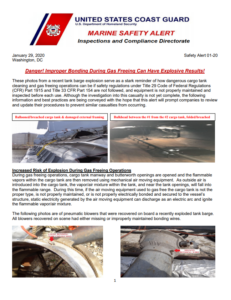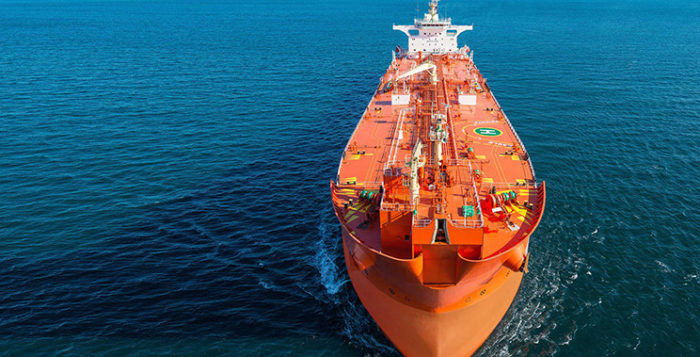The Office of Investigations and Casualty Analysis recently issued a Marine Safety Alert, focusing on the dangers related with improper tank cleaning and gas freeing operations. Following several investigations upon a tanker barge which exploded during cargo tank cleaning , USCG provides its recommendations to avoid such incidents.
Namely, USCG highlighted that if the safety regulations under Title 29 Code of Federal Regulations (CFR) Part 1915 and Title 33 CFR Part 154 are not followed, then cargo tank cleaning and gas freeing operations can result serious accidents.
Moreover, the personnel should keep in mind that equipment must be properly maintained and inspected before each use.
Although USCG has still the tanker’s explosion under investigation, published a list of best practices in order shipping companies to review, updated their procedures, and overall avoid similar casualties from happening.
USCG noted:
When on a gas freeing operation, cargo tank manwat and butterworth openings are opened and the flammable vapors within the cargo tank are then removed using mechanical air-moving equipment. While the outside air is being introduced into the cargo vessel, the vapor/air mixture within the tank, and near the tank openings, will fall into the flammable range.
If the air moving equipment used to gas free the cargo tank is not properly maintained or not properly electrically bonded and secured to the vessel’s structure, static electricity generated by the air moving equipment can discharge as an electric arc and ignite the flammable vapor/air mixture.
The photos above, are of pneumatic blowers that were recovered onboard a recently exploded tank vessel. Specifically, all blowers recovered on scene had been missing or were not properly maintained bonding wires.


In light of the situation, Coast Guard strongly advises all the crewmembers who work at marine facilities or are onoboard ship invovled with cargo tank cleaning and gas freeing operations, to adopt the following actions:
- Ensure that the recommendations outlined in Coast Guard Marine Safety Alert 10-14 have been incorporated into the SOPs used by personnel when on cargo tank cleaning/gas freeing operations.
- Make sure that actions and practices taken by crewmembers involved in cleaning and gas freeing, follow all the applicable requirements of 33 CFR Part 154 and 29 CFR Part 1915.
- All the personnel must be well-educated on the critical importance of the bonding wire/strap on air moving equipment (blowers/fans), while understand that the proper bonding of blowers/fans used in cargo tank cleaning and gas freeing operations is a federal requirement under 29 CFR § 1915.13(b)(11).
- All the crewmembers must be specifically trained on how to secure blowers/fans in place to prevent movement/rattling properly, due to vibration and how to bond blowers/fans to the vessel/barge structure. Simply touching/resting the blower/fan to bare metal is NOT an adequate means of bonding.
- Install policy/procedures in order to inspect all air moving equipment, such as portable blowers/fans, prior to first use on each workday.
- Ensure that all attached accessories are tightly connected to the blower/fan, and that each blower/fan has a bonding wire/strap that is undamaged, free of corrosion, and securely fastened to the housing of the blower/fan.
- Implement a policy in order to require the site Safety Supervisor, SCP or PIC of the cleaning/gas freeing operation to visually inspect each blower/fan to ensure that they are properly secured to prevent movement/rattling and that they have been securely bonded to bare metal on the vessel structure by use of a bonding wire/strap with clamp (or other mechanical means to provide a secure connection). These These checks should be completed before activating the blowers and fans.
To explore more, click on the PDF herebelow


































































